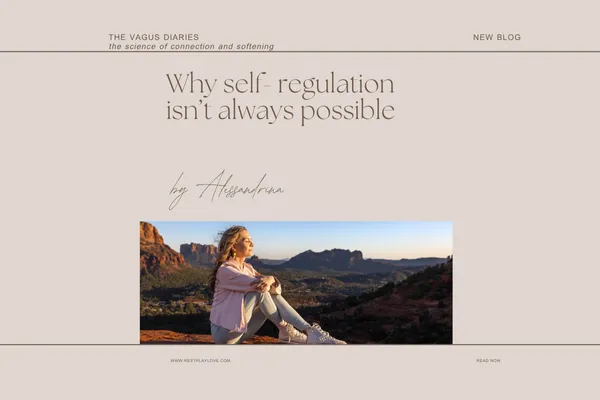
Why Self-Regulation Isn't Always Possible
Why Self-Regulation Isn't Always Possible: Understanding Survival Patterns and the Path Back to Connection
By Alessandrina Dorer, 10-25-25

Prefer to listen? Sometimes receiving information through sound allows for more softening than reading.
You've read all the books. You know the breathing techniques and how to 'hack' your vagus nerve. You understand that you're supposed to "self-soothe" and "self-regulate" to be healthy, relaxed, and social. But sometimes, no matter how hard you try, your nervous system just won't settle.
And then comes the shame and self-criticism. The quiet, nagging voice that whispers: Everyone else can do this. Why can't I?
I'd love to share something with you that's going to change that: Sometimes self-regulation isn't possible—not because you're doing something wrong, but simply because your nervous system learned to distrust others and, that isolation was safer than connection.

The Neuroscience of Isolation as Safety
To understand why self-regulation can feel impossible, we need to talk about neuroception—a term coined by Dr. Stephen Porges, creator of Polyvagal Theory.
Neuroception is your nervous system's constant, subconscious surveillance system. Below your conscious awareness, your body is always asking: Am I safe? Is this person safe? Is this environment safe?
When you're young, your nervous system learns what "safe" means through repeated experiences with caregivers. If those caregivers were consistently attuned, responsive, and regulating, your nervous system learned: Connection equals safety.
But if caregivers were unpredictable, absent, overwhelmed, neglectful, or even frightening, your nervous system learned something entirely different: Connection equals danger. Alone equals safe.
This isn't a conscious belief. It's a deeply encoded survival pattern written into your autonomic nervous system—the part of you that operates faster than thought.
The Biology of "Doing It Alone"
When connection repeatedly leads to disappointment, rejection, or harm, your nervous system adapts. It might move into:
Hypervigilance (sympathetic activation): Always scanning for threat, never fully relaxing, maintaining control by staying alert
Shutdown (dorsal vagal): Numbing out, disconnecting from feelings and needs, conserving energy by going inward
A combination of both: Oscillating between anxious activation and depressive collapse
In all of these states, your body is essentially saying: I can't rely on others. I have to handle this myself.
And here's the painful irony: The very thing that could help you regulate—co-regulation through safe connection— now feels threatening.

Why "Self-Regulation" Can Feel Impossible
We need to get clear about something foundational: Human beings are not designed to self-regulate in isolation.
We are social mammals. Our nervous systems are wired for co-regulation first—the experience of being calmed, soothed, and regulated through connection with another nervous system.
Infants cannot self-regulate. They need a caregiver's regulated presence to help them return to calm. Through hundreds of thousands of these co-regulating experiences, the child's nervous system gradually internalizes the capacity to self-soothe.
Self-regulation, in other words, is internalized co-regulation.
But what happens when those co-regulating experiences were insufficient, inconsistent, or absent?
Your capacity for self-regulation never fully develops. Not because there's anything wrong with your brain or nervous system, but because you were trying to learn a skill without the necessary foundation.
It's like being told to write an essay in a language you were never taught, and then being shamed for not knowing the words.
The Cruel Catch-22
This creates a devastating bind:
You need connection to regulate
But connection feels unsafe
So you isolate
Which keeps you dysregulated
Which makes you need connection even more
But connection still feels unsafe...
You end up stuck in a loop where the medicine (connection) feels like poison.

Survival Patterns Aren't Weakness: They're Protection
Before we go any further, I want to share this with you:
Your survival patterns are not weakness. They are evidence of your nervous system's brilliant capacity to adapt. They are your superpowers of adaptation.
If you learned to shut down emotions to avoid overwhelming a fragile parent, that was adaptive.
If you learned to be hyper-independent because asking for help led to disappointment, that was protective.
If you learned to numb out because feeling was too much to bear alone, that was survival.
These patterns kept you alive. They helped you navigate an environment where connection wasn't safe.
The problem isn't that these patterns exist. The problem is that they're still running, even though your environment may have changed.
Your nervous system is still operating from old data, still believing that isolation is the safest option—because at one point, it absolutely was.
The Intelligence of Isolation
Let's honor what isolation has done for you:
It protected you from repeated disappointment
It kept you from being too vulnerable with unsafe people
It allowed you to develop self-sufficiency and resilience
It gave you a sense of control when everything felt chaotic
These aren't failures. They're adaptations.
And now, perhaps, you're ready to explore whether there might be another way—not because the old way was wrong, but because you want to connect with others and experience loving, supportive relationships that help you remain regulated.

When We've Lived in Survival Mode
When survival becomes your baseline, your entire system recalibrates around one goal: staying alive.
In survival mode:
Your window of tolerance shrinks
Your threat detection becomes hypersensitive
Your capacity for social engagement diminishes
Your body prioritizes defense over connection
Neurologically, this means your sympathetic (fight/flight) and dorsal vagal (freeze/shutdown) pathways are running the show. Your ventral vagal system—the part that allows for social engagement, play, rest, and connection (love)—goes offline.
In this state, self-regulation isn't just difficult. It's neurobiologically limited.
You can't think your way into ventral vagal safety. You can't willpower your way there. You need something external to help your nervous system remember that safety is possible.
You need co-regulation.

How Safety Slowly Returns
Here's the hopeful truth: Safety can become real again. Connection can feel possible again. But it happens slowly, gently, and at the pace your nervous system can tolerate. Because healing happens at the pace of safety and trust.
Healing isn't about forcing yourself to connect before you're ready. It's about creating conditions where your nervous system can gradually update its threat assessment and build greater capacity.
Small Steps Toward Connection
Rebuilding your capacity for co-regulation might look like:
1. Micro-doses of connection
A brief text exchange with someone safe
Sitting in the same room with someone without needing to talk
Sharing something small and noticing how your body responds
2. Safe-enough people
Not perfect people, but people who are:
Consistent and reliable
Non-judgmental and accepting
Regulated enough to hold space for your dysregulation
Willing to go slow
3. Therapeutic relationships
Working with a trauma-informed coach or therapist who understands nervous system healing
Joining a support group where vulnerability is normalized and encouraged
Finding communities (like our Nervous System Healing Sanctuary) where co-regulation is practiced
4. Noticing softening
Pay attention to moments when connection helps you soften
When someone's calm presence makes your shoulders drop, or puts a smile on your face
When shared silence feels steadying and nourishing instead of suffocating
When you don't have to explain yourself to feel held
These moments are gold. They're your nervous system gathering new data: Connection can be safe. I don't have to do this alone.
The Role of Choice and Pace
The most important thing in this process is that you get to choose:
You choose who to connect with
You choose how much to share
You choose when to step back
You choose the pace
This isn't the kind of connection you experienced as a child, where you had no control or say. This is adult connection, where your boundaries matter and your "no" is respected.
That sense of agency—of being in the driver's seat—is what allows your nervous system to risk vulnerability again and become more flexible.
Building Tolerance for Co-Regulation
Think of it like physical therapy after an injury. You don't immediately lift heavy weights. You start with gentle movements, building strength gradually.
Co-regulation is the same. You're building your tolerance for:
Being seen
Being held emotionally
Receiving care
Trusting another person's steadiness
Each small experience of safe connection adds to your nervous system's capacity and resilience. Over time, connection stops feeling so threatening. The fear quiets. The walls soften.
And slowly—sometimes so slowly you barely notice—you start to internalize that regulated presence. You start to become for yourself what others have been for you.
That's when self-regulation becomes genuinely possible.

The Path Forward
If you've made it this far, please always remember that you're not broken and your nervous system is not defective or lacking. You're not failing at self-regulation. You're learning a skill you were never properly taught, and you're learning it now, as an adult, which is incredibly brave. Your building your nervous system's capacity, flexibility, and resilience.
Here are some suggestions to support you on your path forward into more consistent regulation:
Self-regulation is internalized co-regulation. You needed safe connection to build that capacity. If it wasn't there, the capacity couldn't fully develop. That's not your fault.
Survival patterns are adaptive, not shameful. Your nervous system did what it needed to do to keep you safe. Please remember, and honor that.
Healing happens in connection. You don't have to do this alone anymore. Safe, attuned connection is the medicine, and it's possible with the 'right' people.
Go at your own pace. Your nervous system will tell you when it's ready for more. Trust that. Only move forward when it gives you the green light.
Notice the softening. Those moments when connection helps you settle and soften—they're proof that your nervous system is learning something new.
You deserve to experience co-regulation. You deserve to feel held, seen, and safe in the presence of others. And you deserve to eventually carry that safety within yourself.

Join Us
If you're ready to explore what co-regulation can feel like in community, we'd love to have you in our Nervous System Healing Sanctuary.
This is a space where:
We practice regulation together
We honor the wisdom of survival patterns
We move at the pace of safety and trust
We understand that healing isn't linear
Because sometimes the most healing thing you can do is stop trying to regulate alone—and let yourself be held by a nervous system that's steady and resilient enough to meet you where you are.
Learn more at restplaylove.com
Notice when connection helps you soften. That's your nervous system remembering it doesn't have to carry everything alone.